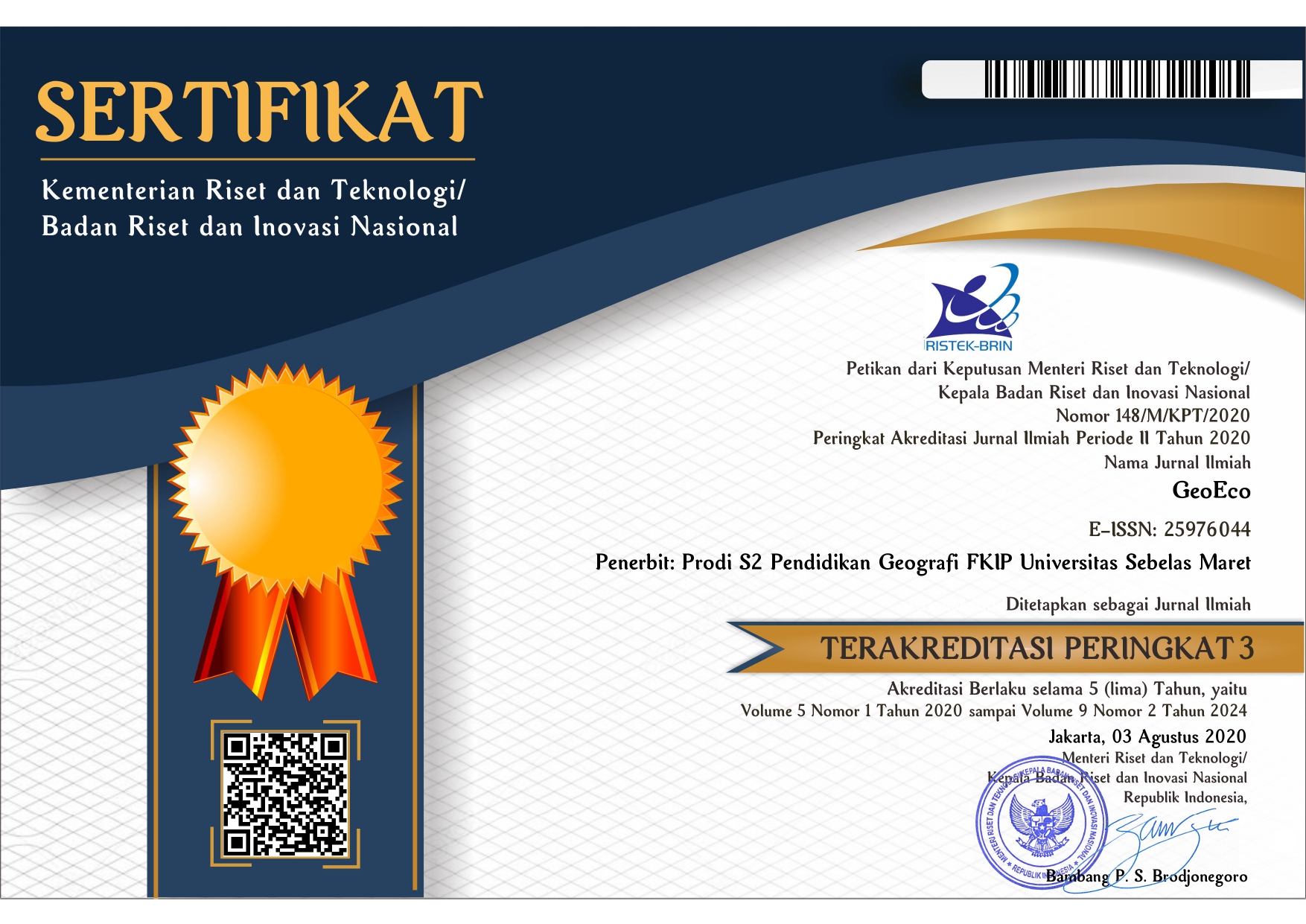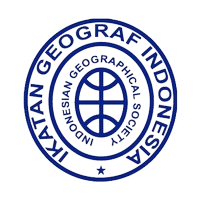FLOOD HAZARD MAPPING BASED ON MULTI-CRITERIA SPATIAL ANALYSIS IN THE SAMIN WATERSHED, INDONESIA
Abstract
Keywords
Full Text:
PDFReferences
Atharinafi, Z., & Wijaya, N. (2021). Land use change and its impacts on surface runoff in rural areas of the upper citarum watershed (case study: Cirasea subwatershed). Journal of Regional and City Planning, 32(1), 36–55. https://doi.org/10.5614/jpwk.2021.32.1.3
Bubeck, P., Botzen, W. J. W., & Aerts, J. C. J. H. (2012). A Review of Risk Perceptions and Other Factors that Influence Flood Mitigation Behavior. Risk Analysis, 32(9), 1481–1495. https://doi.org/10.1111/j.1539-6924.2011.01783.x
Budiarti, W. at all. (2017). View of Upaya Mitigasi Banjir di Sub DAS Samin Melalui Pengembangan Masyarakat Tangguh Bencana.pdf.
Caruso, G. D. (2017). The legacy of natural disasters: The intergenerational impact of 100 years of disasters in Latin America. Journal of Development Economics, 127(March), 209–233. https://doi.org/10.1016/j.jdeveco.2017.03.007
Entin Hidayah, Gusfan Halik, Indarto Indarto, D. W. K. (2021). Flood hazard mapping of the Welang river, Pasuruan, East Java, Indonesia. Journal of Applied Water Engineering and Research, 11(3), 333–344.
Kankanamge, N., Yigitcanlar, T., Goonetilleke, A., & Kamruzzaman, M. (2020). Determining disaster severity through social media analysis: Testing the methodology with South East Queensland Flood tweets. International Journal of Disaster Risk Reduction, 42(June 2019). https://doi.org/10.1016/j.ijdrr.2019.101360
Kazakis, N., Kougias, I., & Patsialis, T. (2015). Assessment of flood hazard areas at a regional scale using an index-based approach and Analytical Hierarchy Process: Application in Rhodope-Evros region, Greece. Science of the Total Environment, 538, 555–563. https://doi.org/10.1016/j.scitotenv.2015.08.055
Kundzewicz, Z. W., Kanae, S., Seneviratne, S. I., Handmer, J., Nicholls, N., Peduzzi, P., Mechler, R., Bouwer, L. M., Arnell, N., Mach, K., Muir-Wood, R., Brakenridge, G. R., Kron, W., Benito, G., Honda, Y., Takahashi, K., & Sherstyukov, B. (2014). Le risque d’inondation et les perspectives de changement climatique mondial et régional. Hydrological Sciences Journal, 59(1), 1–28. https://doi.org/10.1080/02626667.2013.857411
Mardikaningsih, S. M., Muryani, C., & Nugraha, S. (2017). Studi Kerentanan dan Arahan Mitigasi Bencana Banjir di Kecamatan Puring Kabupaten Kebumen Tahun 2016. Jurnal Geo Eco, 3(2), 157–163.
Mostofi Zadeh, S., Burn, D. H., & O’Brien, N. (2020). Detection of trends in flood magnitude and frequency in Canada. Journal of Hydrology: Regional Studies, 28(February 2019). https://doi.org/10.1016/j.ejrh.2020.100673
Mudashiru, R. B., Sabtu, N., Abustan, I., & Balogun, W. (2021). Flood hazard mapping methods: A review. Journal of Hydrology, 603(PA), 126846. https://doi.org/10.1016/j.jhydrol.2021.126846
Perdana, Redho Surya, et. al. (2019). Flood Hazard Mapping Using GIS Spatial Analisis Functions in Baleedah, Bandung, West Java. Rabit : Jurnal Teknologi Dan Sistem Informasi Univrab, 1(1), 2019.
Razavi Termeh, S. V., Kornejady, A., Pourghasemi, H. R., & Keesstra, S. (2018). Flood susceptibility mapping using novel ensembles of adaptive neuro fuzzy inference system and metaheuristic algorithms. Science of the Total Environment, 615, 438–451. https://doi.org/10.1016/j.scitotenv.2017.09.262
Rosser, J. F., Leibovici, D. G., & Jackson, M. J. (2017). Rapid flood inundation mapping using social media, remote sensing and topographic data. Natural Hazards, 87(1), 103–120. https://doi.org/10.1007/s11069-017-2755-0
Saaty, T. . (1980). A scaling method for priorities in hierarchical structures. Journal of Mathematical Psychology, 15(3), 234–281.
Saaty, T., & Vargas, L. (2012). Models, methods, concepts & applications of the analytic hierarchy process. … -Driven Demand and Operations Management Models, 1–20. https://doi.org/10.1007/978-1-4614-3597-6
Sajikumar, N., & Remya, R. S. (2015). Impact of land cover and land use change on runoff characteristics. Journal of Environmental Management, 161, 460–468. https://doi.org/10.1016/j.jenvman.2014.12.041
Sholeh, S., & Yusup, Y. (2023). Cross-Border Flood Management in Bengawan Solo Hulu Watershed. GeoEco, 9(2), 215. https://doi.org/10.20961/ge.v9i2.74476
Sonu, T. S., Mohammed Firoz, C., & Bhagyanathan, A. (2022). The impact of upstream land use land cover change on downstream flooding: A case of Kuttanad and Meenachil River Basin, Kerala, India. Urban Climate, 41(April 2021), 101089. https://doi.org/10.1016/j.uclim.2022.101089
Tehrany, M. S., Pradhan, B., & Jebur, M. N. (2014). Flood susceptibility mapping using a novel ensemble weights-of-evidence and support vector machine models in GIS. Journal of Hydrology, 512, 332–343. https://doi.org/10.1016/j.jhydrol.2014.03.008
Refbacks
- There are currently no refbacks.












.png)

